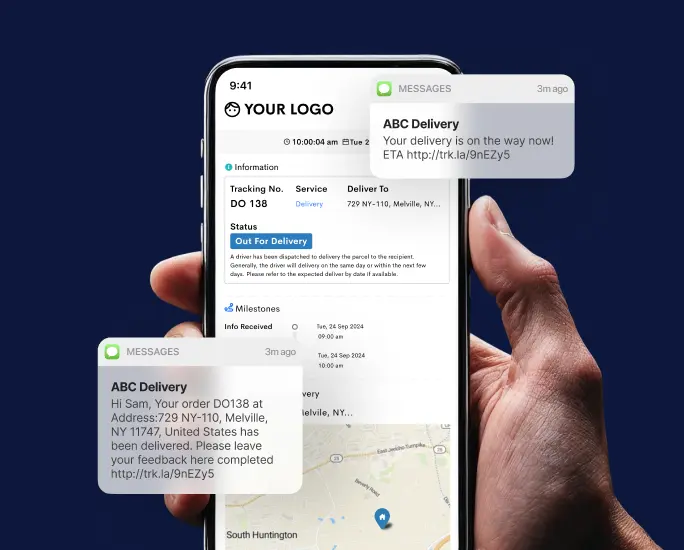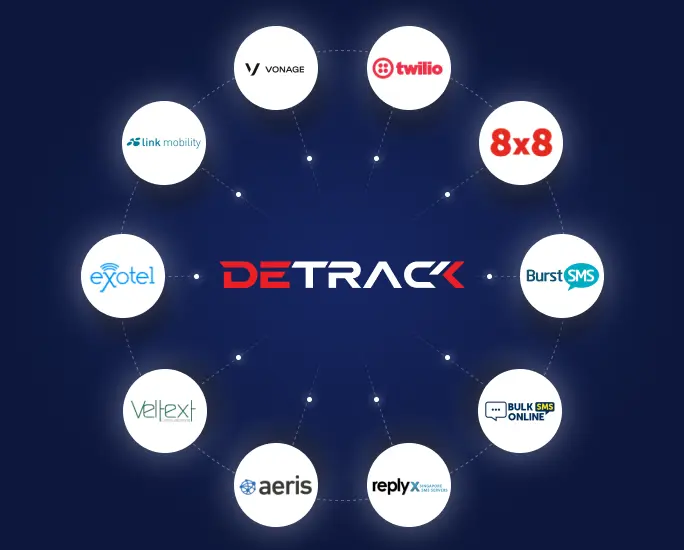The rise of technological advancement has created more expectations for customers in the delivery and eCommerce industry. They now expect their packages to be delivered as soon as possible. But what happens when your order is too large or out-of-stock items are included? That’s where last-mile carriers come in.
By using parcel tracking software, you can keep tabs on your package every step of the way — from the time it leaves your door until it arrives at its final destination. Here’s a closer look at last-mile carrier tracking and how it works.
What Is Last-Mile Tracking?
Delivery businesses always want to know where packages are at all times during last mile delivery in order to manage their operations and provide the best possible service properly. For the customers, there’s an expectation to know their package’s estimated arrival time for assurance.
Last mile tracking is the process of tracking a package’s location during the last mile fulfilment stage — from when the package leaves the distribution center or warehouse to when it gets to the customer’s location.
Last mile delivery tracking is necessary as it offers insights into a shipment’s location at any given moment, giving companies more control over their supply chain. Additionally, last-mile carrier tracking can help customers receive their orders faster and more accurately, resulting in a better overall customer experience.

Types of Last Mile Tracking
There are different types of last mile delivery tracking systems that businesses use to ensure that there’s visibility on all packages during the delivery process. Below are some of them:
GPS Tracking
GPS is a type of technology used for tracking that has become really popular around the world. It’s an acronym for Global Positioning System. Basically, GPS tracking involves the use of network satellites that orbit the Earth and other devices to determine the exact location of an object or person.
In last mile courier tracking, GPS tracking requires a tracking device to be installed in the delivery van or vehicle. That way, the device will provide information about the exact vehicle location, allowing for real-time tracking.
Delivery businesses use GPS tracking to locate a truck’s location, get specific reports on traffic situations, and monitor the time each vehicle or truck spends at a delivery location.
RFID Tracking
Also known as radio frequency identification, RFID is a type of last mile delivery tracking that uses intelligent barcodes to monitor and identify packages using radio frequency technology.
RFID tags can hold a plethora of information — from serial numbers to several data pages like date of manufacture, location, movement, and storage requirements. This information is vital for organizing package delivery in the final mile delivery process.
Online eCommerce stores and delivery services use RFID technology to track the movement of packages through the delivery chain and identify any costly delay in their operations. This helps to eliminate any need for using manual methods in monitoring packages like spreadsheets. Consequently, it reduces the need for extra staff time, saving you additional operational costs.
Barcode Scanning
Several eCommerce and delivery businesses lose a lot of money every year due to misplaced or lost products. Today, barcode scanning is used as a type of last mile courier tracking to reduce the number of lost packages and increase efficiency. Barcodes help track an order’s status, location, package information, and history.
Barcode scanning is one most common type of last mile tracking as they help businesses monitor their product’s status and keep relevant records. It can also be used to identify how long an item has been in stock. In the delivery chain, barcode makes it easy to track inventory precisely, reducing any chance for human error and improving efficiency.
Barcode scanners are used to scan an incoming delivery into a package tracking application, then the tracking software scans the package again when it’s delivered to the customers and serves as proof of delivery and a way to capture their signature.
Geofencing
In this type of tracking, GPS-based geofencing perimeters are set around the locations for last-mile delivery so businesses can track their fleet’s movements around and in the geofence.
Geofencing is a location-based tracking service that utilizes GPS, cellular data, Wi-Fi, or RFID to trigger a trace when a vehicle leaves its geographical delivery area. The information obtained can help optimize delivery routes, monitor packages, and update customers on their package’s ETA.
Also, if there’s a delivery delay, you can quickly identify which driver and vehicle is behind and reroute other vehicles to prevent more delays. Geofencing gives businesses real-time insight to adjust their strategy for better planning and scheduling.
Mobile App Tracking
This is the most commonly used last mile delivery tracking option. Mobile app tracking is a software application businesses use to allow their customers to track the progress of their package delivery on a live map. It also affords the business the same luxury of tracking their drivers.
Some mobile tracking apps offer more comprehensive options, like allowing drivers to capture real-time electronic proof of delivery (E-POD). Most mobile tracking applications also provide additional information about the driver’s real-time location and the number of stops they’ll make.
While others allow customers to view photographs of the vehicle and driver and even communicate via in-app call or text messaging. Using mobile application tracking allows businesses to reduce the time spent on route planning by 95% and efficiently increase their delivery routines.

Benefits of Last Mile Tracking
It is essential to manage your customers’ expectations and provide them with transparency, and that’s where last mile tracking comes into play. There are several benefits it provides businesses, including visibility on packages. Below we’ll take a look at them.
Improved Delivery Accuracy
Last mile delivery tracking can help businesses to improve their delivery efficiency by providing their drivers with real-time updates on traffic around their routes and even changes to their routes. The information can, in turn, help the drivers to make changes to their routes and schedules, ensuring that they deliver the packages accurately and on time.
Enhanced Customer Experience
Customers need reliable and prompt delivery of their packages, and lack of visibility is one of the primary last mile delivery challenges that makes package delivery slow and affect a customer’s experience.
Customers appreciate when they can track their package and know its ETA, reducing anxiety and frustration. By providing all customers with accurate and timely information about their packages, last mile delivery tracking can help improve customer experience and satisfaction. Additionally, last mile courier tracking enables a customized and more flexible method for distribution.
Reduced Delivery Times and Costs
Tracking packages through the last mile process eliminates the possibility of unplanned diversion. It ensures that all drivers take the fastest and shortest possible routes, reducing operational costs spent on items like fuel and ensuring packages are delivered timely.
Last Mile Visibility
In last mile delivery, visibility is one of the most notable challenges experienced. However, last mile delivery tracking offers businesses real-time visibility on their vehicle’s current location, if they’re diverting from their scheduled route, and time spent at each drop. Essentially, this provides a solution to the aforementioned problem.
Tracking delivery in the final mile not only improves the delivery chain, it also gives logistics managers more control over the fleets, helping to reduce spoilage and theft.
Most Common Last-Mile Tracking Setups
Below are some of the common setups for last-mile tracking that makes the process very effective.
Sms And Email Notifications
SMS and email notifications allow businesses to communicate effectively with customers, ensuring they’re always up-to-date on their orders. This can be especially beneficial for remote deliveries, as it allows businesses to keep customers informed without having to make a physical visit.
Last-mile tracking setups provide an added layer of security, allowing businesses to track the location of deliveries in real-time. This helps ensure that packages arrive on time and to the correct address, reducing the amount of customer dissatisfaction that might otherwise arise from delays or wrong deliveries.
A Direct Line To The Driver Or Delivery Service
Last-mile tracking is an invaluable tool for both drivers and companies alike. With this technology, companies can provide a direct line of communication to their drivers or delivery service personnel, making them aware of the package’s exact location at all times. This helps ensure that packages are delivered on time and without any issues.
Furthermore, it gives companies greater control over the delivery process and can reduce the risk of lost or stolen packages.
Proof Of Delivery Tracking (POD)
POD Last-Mile Tracking Setups are an invaluable tool in eCommerce and logistics, providing visibility into the last stretch of a delivery’s journey. This system allows customers to track their orders from when they leave the warehouse until they reach their doorstep.
With POD tracking setups, businesses can offer reliable customer service, reduce the risk of lost or damaged packages, and ensure that products are delivered on time.
Live Package Tracking Portal
The live package tracking portal provides real-time updates on your package delivery status. The last-mile tracking setups allow customers to monitor their packages every step of the way. This process helps improve accuracy, customer satisfaction, and service levels and reduce missed deliveries or return costs.
Customers can receive automated notifications when a package is delivered, out for delivery, in transit, or ready for pickup. They can also view a tracking history of their package and receive immediate updates on any changes in the shipment’s status. The live package tracking portal integrates various order management systems to track packages quickly and accurately.
Last mile tracking in the palm of your hand
Last-mile carrier tracking is a process that helps businesses and consumers track their shipments from the moment they leave the warehouse to when they arrive at their final destination. By understanding how last-mile carrier tracking works, you can be sure your shipments will always arrive on time and in good condition.
Detrack is a delivery management software that can help you track your fleets through the last mile process. Our application is compatible with iOS and Android devices. Try Detrack Today and see how our Tracking Widget can help your customers see their delivery coming to them live on a map, down to the second. Thereby reducing inquiry calls and allocating more time to growing your business.









